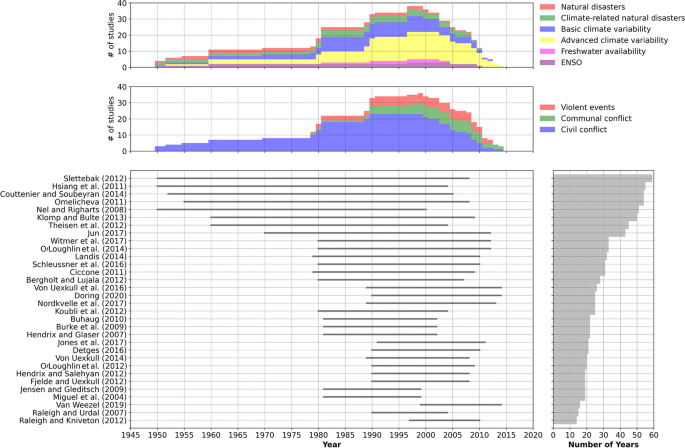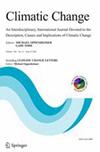What climate? The different meaning of climate indicators in violent conflict studies
IF 4.8
2区 环境科学与生态学
Q1 ENVIRONMENTAL SCIENCES
引用次数: 0
Abstract
Abstract This paper explores the operationalization of climate-related indicators in violent conflict research. The climate-conflict narrative gained traction in recent decades and climate change is often referred to as a ‘threat multiplier’ by both policy makers and scholars. Yet, the relationships between climate-related phenomena and violent conflict are complex and context-specific. However, limited attention has been given to the climatic indicators applied in climate-conflict research. This paper addresses that gap by analyzing 32 studies published from 2004 to 2020 on the operationalization of climatic indicators and their relationship with violent conflict. It first categorizes climate indicators operationalization into five clusters: natural disasters, basic climate variability, advanced climate variability, freshwater availability, and the ENSO. The study evaluates the climate indicators for each cluster and shows that at an aggregate level these clusters examine 68 different climate representations. When paired with their respective conflict types, it finds a total of 113 climate-conflict combinations. Most operationalizations represent various forms of climate-related phenomena and variability rather than climate change. Some indicators are advancements over time, for example moving from changes in average rainfall to standardized precipitation indices. However, other indicators refer to various natural processes, making it challenging to determine whether climatic variability impacts conflict. The paper then demonstrates a discrepancy between the pathways through which climate may affect violent conflict and the representation of these pathways in the selected climate indicators. It discusses how the selection and operationalization of climate indicators requires careful consideration, and the phenomena researched should be well-specified in research findings.

什么气候?气候指标在暴力冲突研究中的不同意义
本文探讨了气候相关指标在暴力冲突研究中的可操作性。近几十年来,气候冲突的说法越来越受关注,气候变化经常被政策制定者和学者称为“威胁倍增器”。然而,与气候有关的现象与暴力冲突之间的关系是复杂的,并因具体情况而异。然而,气候指标在气候冲突研究中的应用受到的关注有限。本文通过分析2004年至2020年发表的32项关于气候指标运作及其与暴力冲突关系的研究,解决了这一差距。首先,将气候指标的运行分为五类:自然灾害、基本气候变率、高级气候变率、淡水可利用性和ENSO。该研究评估了每个集群的气候指标,并表明在总体水平上,这些集群检查了68种不同的气候表征。当与它们各自的冲突类型配对时,它发现总共有113种气候冲突组合。大多数业务化代表各种形式的气候相关现象和变率,而不是气候变化。有些指标是随着时间的推移而进步的,例如从平均降雨量的变化转向标准化降水指数。然而,其他指标涉及各种自然过程,因此很难确定气候变率是否会影响冲突。然后,本文论证了气候可能影响暴力冲突的途径与所选气候指标中这些途径的表现之间的差异。讨论了气候指标的选择和实施需要慎重考虑,研究结果中应详细说明所研究的现象。
本文章由计算机程序翻译,如有差异,请以英文原文为准。
求助全文
约1分钟内获得全文
求助全文
来源期刊

Climatic Change
环境科学-环境科学
CiteScore
10.20
自引率
4.20%
发文量
180
审稿时长
7.5 months
期刊介绍:
Climatic Change is dedicated to the totality of the problem of climatic variability and change - its descriptions, causes, implications and interactions among these. The purpose of the journal is to provide a means of exchange among those working in different disciplines on problems related to climatic variations. This means that authors have an opportunity to communicate the essence of their studies to people in other climate-related disciplines and to interested non-disciplinarians, as well as to report on research in which the originality is in the combinations of (not necessarily original) work from several disciplines. The journal also includes vigorous editorial and book review sections.
 求助内容:
求助内容: 应助结果提醒方式:
应助结果提醒方式:


